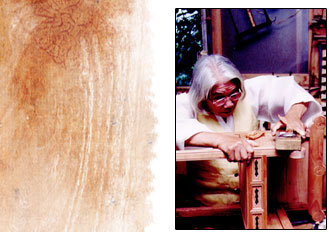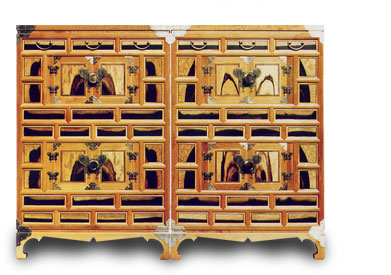Seol Seok-cheol opened his own workshop when he was 24 years old. Traditional tables and chests, including bandaji and dwiju, were his main products although he made various types of office furniture, too. His interest at the time, and today still, was producing a fine work of art rather than merchandise that could make money. Although he was a superb craftsman, he wasn't a smart businessman and suffered from serious financial problems, often falling deep into debt. His strong will to make “good” natural wood furniture, however, was not affected by his economic woes. He often worked the whole night through for the pleasure of seeing a fine piece of furniture being created by his hands. The first of the two hardest trials of his life came at 38 years of age when he fell from a tree and broke his right leg, permanently affecting his body. The tree from which he fell was the dangsan ('village guardian') tree, a Zelkova, in the village of Seongsan-ri within the town of Jangseong―It was a huge tree with its trunk as thick as three meters in diameter and was presumed to be more than 1000 years old. When the tree died, the villagers sold it to Seol, but he needed to saw off the branches before cutting it down. However, after he climbed up the tree, he was hit by a large falling branch that he had severed and he fell to the ground. The accident kept him in bed for a whole year, while his neighbors said that he would soon die because the spirit of the village guardian had cursed him for what he had done. But Seol wasn't superstitious and knew that it was just an accident, although he didn’t use the wood of this village guardian but kept it with him, even until this day. He still uses the wood as a lesson for his children and as a mirror with which he looks at his life as a carpenter. The second tragic accident took place when he was 63 years old. This time a sharp piece of wood sprang from the cutting machine, breaking his glasses and directly hitting his left eye, eventually blinding him in it. Impaired visibility is a great loss for any woodworker for whom correct measurement is the most important factor for creating excellent work. These accidents left permanent scars on his body, but strengthened, rather than weakened, his will to devote his life to carpentry. His answer is simple. “People ask me how I can continue to work with wood after such a painful experience. For such a question, I can only say that this is what I could do, and should do, because it would be very difficult then, as much as now, for me to learn something new and have a new job with all those unfortunate things that happened to me.” Although his eyesight is debilitated, he has gained an almost superhuman sense of touch. His two sons, working under him for more than 20 years to succeed the family tradition bequeathed from their ancestors of four generations, are always amazed at the exemplary skill of their senior. “We make things after careful measurement, whereas our father does everything only by depending on his tactual senses and the imperfect sight. The result, however, is that he always comes with a perfect piece without an error, much better work than ours. We always feel that we are left far behind.” a title listed by the Korean government as 'Important Intangible Cultural Property No. 55.' He says that his heart still beats wildly whenever he discovers Zelkova and Black Persimmon with their beautiful grain, or Paulownia or Pine, which feel soft to the touch. He may be old physically, but his passion is like a young man's―ageless. View the master's works |
|||||||||||
|




















